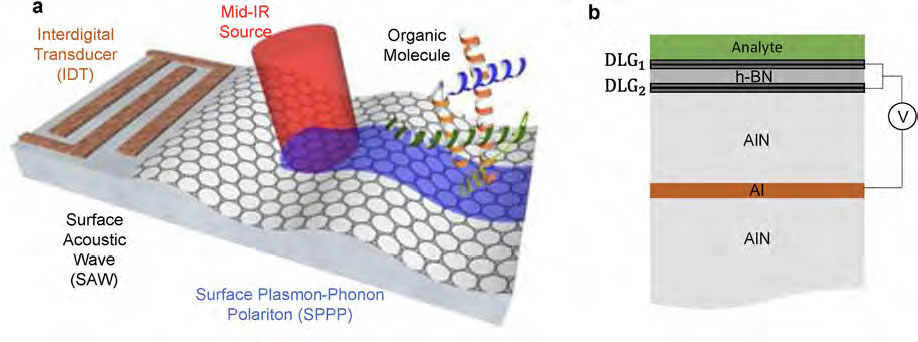| Jan 23, 2024 | |
Graphene biosensor uses sound waves for chemical fingerprinting of ultrathin biolayers |
|
| (Nanowerk Spotlight) Infrared spectroscopy allows scientists to study molecules by analyzing their unique vibrational signatures, which act as chemical fingerprints. However, conventional infrared techniques still struggle to detect ultrathin biolayers like those critical for tissue engineering, bioelectronic implants, environmental sensing, and fundamental cell biology. Though surface enhancements can amplify signals, they have tradeoffs that limit reliable identification and quantification. | |
| Infrared spectroscopy relies on the fact that molecules vibrate at specific resonant frequencies based on their chemical bonds. By shining infrared light on a sample and measuring absorption, a spectrum of these molecular vibrations can be obtained. This vibrational fingerprint uniquely identifies the molecular composition, similar to how a fingerprint identifies a person. It also contains information on molecular shape and structure. This makes infrared spectroscopy invaluable for chemistry, biology, and medicine. | |
| However, free infrared light beams are too crude and energetic to sense ultrathin molecular layers like those involved in tissue engineering, pathogen detection, and environmental toxin assessment. Although graphene plasmons and metamaterials can compress light beyond its diffraction limit, previous techniques still lacked the sensitivity and precision to reliably detect angstrom-scale biofilms. | |
| Though surface-enhanced infrared absorption (SEIRA) spectroscopy using metal antennas and graphene plasmonics can confine light beyond its diffraction limit, these platforms have tradeoffs. Metal structures lack tunability and suffer from low infrared quality factors. Previous graphene devices required permanent patterning like diffraction gratings that scattered light, reducing polariton lifetimes crucial for precise spectroscopy. These shortcomings have thus far obstructed reliable infrared identification and quantification of fragile biomolecules, especially ultrathin layers. | |
| Now, researchers from Universidad Politécnica de Madrid report in Biosensors and Bioelectronics ("Surface-acoustic-wave-driven graphene plasmonic sensor for fingerprinting ultrathin biolayers down to the monolayer limit") the development of an electrically tunable graphene-based biosensor that leverages sound waves to provide unprecedented infrared sensitivity and specificity at the single layer limit. By precisely matching the tunable graphene plasmon frequency to target molecular vibrations, even faint spectral fingerprints emerge clearly. | |
 |
|
| Schematics of the SAW-driven plasmonic biosensor proposed. (a) 3D layout of the device and (b) cross section of the material system composed of a van der Waals heterostructure on top of an AlN substrate with a buried Al gate that is used to bias the top and bottom double layer graphene (DLG) stacks. (© Biosensors and Bioelectronics) | |
| This acoustically activated approach enables precise in situ study of angstrom-scale films, unlocking new infrared applications across chemistry, biology and medicine. | |
| “Graphene has emerged as an exceptional platform for infrared spectroscopy and sensing,” explains lead author Raúl Izquierdo-López. “Its two-dimensional nature confines light far beyond what metals can achieve. And unlike metals, graphene’s optical properties can be electrically tuned.” | |
| The team stacked two graphene sheets around a thin hexagonal boron nitride spacer on an aluminum nitride substrate. The team modeled the biosensor using a transfer matrix method that considered graphene as a conductive interface between dielectric layers. | |
| By tuning the Fermi level of double graphene layers with electrical gating, they tailored the hybrid graphene plasmon-hBN phonon modes to resonate across infrared frequencies linked to common biological bond vibrations. They then activated the integrated surface acoustic wave device to produce nanoscale sound waves that dynamically “rippled” the graphene stacks. This virtual diffraction grating coupled the propagating graphene polaritons to infrared light at target frequencies without needing permanent nanostructures. | |
| Next, they activated the integrated surface acoustic wave device to produce nanoscale sound waves that propagated across the graphene stacks. This dynamic rippling formed a virtual diffraction grating that coupled the graphene plasmons to free space infrared light at tunable frequencies without fabricating permanent nanostructures. | |
| Simply by gating the Fermi level, the researchers could scan for molecular vibrations of interest, similar to tuning a radio dial. When the graphene plasmon frequency overlapped with a molecular resonance, a transparency window emerged, indicating strong coupling. This signaled the detected molecule’s presence louder than ever before. | |
| To demonstrate sensitivity, the team analyzed nanometer organic films of the semiconductor CBP, protein bilayers combining the recombinant protein A/G and goat anti-mouse IgG antibodies, as well as single layers of the valine gramicidine A peptide which forms conductive ion channels in lipid membranes. The virtual diffraction biosensor effectively fingerprinted all specimens across coupling regimes from initial plasmon broadening to full Fano resonance interference. | |
| “This tunable, non-destructive and reusable technology provides specificity and sensitivity unmatched by standard infrared and plasmonic techniques,” says Dr. Pedrós. “It opens doors for precision infrared study of fragile biomolecules and continuum-scale lab-on-chip sensing without microfluidics.” | |
| The researchers plan to further enhance sensitivity by integrating state-of-the-art high mobility graphene. With optimized materials and a refined acoustic wave mixing technique that suppresses noise, they aim to achieve single molecule infrared spectroscopy within the decade. | |
 By
Michael
Berger
– Michael is author of three books by the Royal Society of Chemistry:
Nano-Society: Pushing the Boundaries of Technology,
Nanotechnology: The Future is Tiny, and
Nanoengineering: The Skills and Tools Making Technology Invisible
Copyright ©
Nanowerk LLC
By
Michael
Berger
– Michael is author of three books by the Royal Society of Chemistry:
Nano-Society: Pushing the Boundaries of Technology,
Nanotechnology: The Future is Tiny, and
Nanoengineering: The Skills and Tools Making Technology Invisible
Copyright ©
Nanowerk LLC
|
|
|
Become a Spotlight guest author! Join our large and growing group of guest contributors. Have you just published a scientific paper or have other exciting developments to share with the nanotechnology community? Here is how to publish on nanowerk.com. |
|
